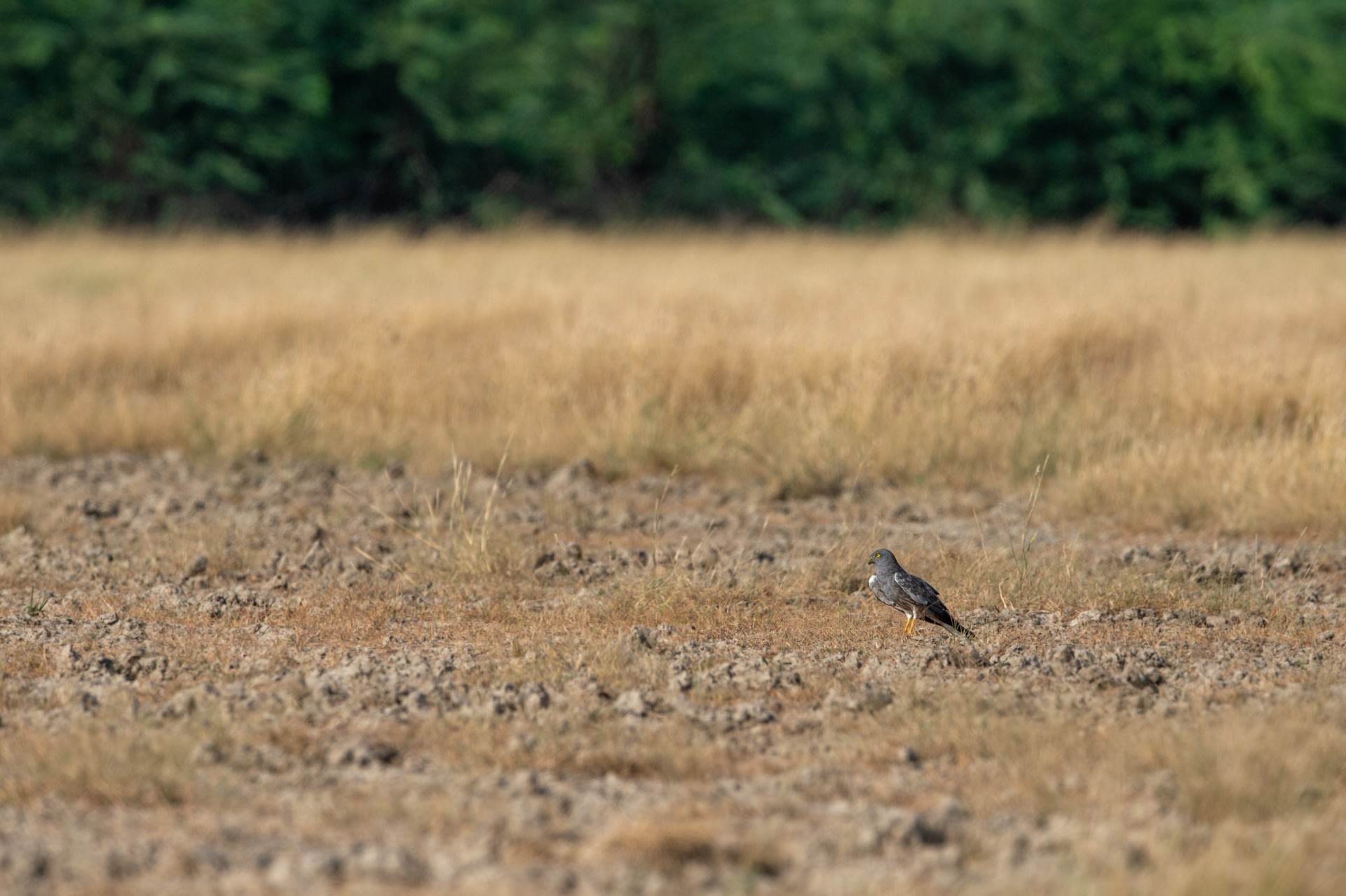Tal Chhapar is a grassland paradise famous for its large number of blackbucks. It’s also the favoured hunting ground for a wide variety (and number) of raptors. Focus your gaze anywhere in the park and you are almost certain to catch sight of a raptor skimming low over the grassland. From the moment you enter this park it is evident that it is the harriers who stand out. Everywhere in this landscape a harrier is on the prowl.

The vast grasslands of the Tal Chhapar Blackbuck Sanctuary in Rajasthan is a favoured hunting ground for many raptors including the Montagu’s harrier. Photo: Sourabh Bharti/Shutterstock A Montagu's harrier flies off after successfully hunting a grasshopper. Grasshoppers, locusts and other insects constitute a large part of a harrier's diet, and many of these raptors time their migration with the movement of insects. Cover Photo: Sambath Subbaiah
Harriers belong to the genus Circus, which is derived from ancient Greek Kirkos meaning circle, referring to a bird of prey and their habit of circling in the sky. Interestingly, a study in 2015 points out that harriers evolved in the late Miocene, which coincides with the formation of grasslands and savannahs as well as the radiation of rodents, which are one of the key mammals in their diet. Of the three species of harriers to be found in Tal Chhapar, one of the most ubiquitous is Montagu’s Harrier. Montagu’s Harrier Circus pygargus is also one of the most common harriers to winter on the Indian subcontinent. Breeding all across Eurasia, they fly to either sub-Saharan Africa or further east towards the Indian subcontinent, where they are found in the states of Rajasthan, Gujarat, Haryana, Delhi, Uttar Pradesh, Madhya Pradesh, Chhattisgarh, Maharashtra, Telangana, Andhra Pradesh, Karnataka, Tamil Nadu, Kerala, and even eastwards in West Bengal and Assam.
Colour coded
Montagu’s Harrier is named after the naturalist George Montagu, who is also known for writing the Ornithological Dictionary in 1802. Measuring between 43 and 47 cm, the adult male of the species is a stunning dark grey with black edges on its wings. It also sports rufous (reddish-brown) streaking on its belly, which is one of the ways by which it can be differentiated from the pallid harrier. Females are a dark shade of brown with bars on their underside and white faces with a prominent supercilium (line above the eye or “eyebrow”). The upper parts are uniform in colour except for the white rump (hence the specific name pugargos; puge meaning “rump” and argos for “white”). Juveniles have a uniform wash of rufous on their underside, contrasting with darker brown upper parts.
Meal deal
Montagu’s harriers, like other harriers, feed primarily on grasshoppers, locusts and other insects, as well as reptiles, rodents, and other small mammals. A study in Spain, conducted over four years, revealed that Montagu’s harriers are generalists (eat many different foods), with 43 per cent of their diet consisting of insects, while birds and mammals constitute 23 per cent and 27 per cent respectively. This, however, changes in different areas as well as across different seasons. In certain seasons, when birds fledge (develop wings to fly), their diet changes to feeding on young birds. It is also believed that Montagu’s, among others, also follow the migratory path of locusts and grasshoppers. In Tal Chhapar, one is often witness to a low-flying Montagu’s harrier on a vigilant watch-out over grass patches, before it dives into the grass and is out of sight. It is at this moment that the harrier sits and enjoys its meal. Hiding in the grassland probably gives it cover from other hungry raptors.
Although its conservation status is one of least concern on the IUCN Red List, studies on long-term monitoring of harriers have revealed a consistent decrease in its populations. One such study, conducted by Harrier Watch (harrierwatch.com) of the Ashoka Trust for Research in Ecology and the Environment, reveals that there has been a steady drop in the number of birds wintering in India from 1985 to 2015. Harriers, like the Montagu’s, are specific to grasslands, farmlands, and open country. However, there is a long history of land-use change and lack of general awareness about the ecosystem services rendered by harriers.
This study examined the roost sites of harriers. A particular roost near Hyderabad showed the complete vanishing of harriers after the grassland was converted into a plantation. This is a consistent threat all across India, because grasslands aren’t given conservation status. The conversion of grassland to agricultural or industrial land, and the invasion of non-native species like Prosopis, has caused rampant loss of habitat. Any conservation measure for harriers needs to pay monitor the grassland habitat they prefer over the long-term. Also essential is to raise awareness about these birds, the habitats they inhabit, and the role they play in the ecosystem, especially among the local populace and policymakers.
